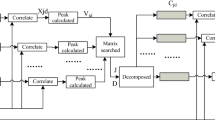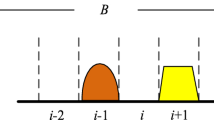Abstract
To cope with the limitations of traditional direct-sequence spread spectrum system application, MBOK signals have been considered owing to their high gain, fast rate, and high frequency band transmission capability. However, to address the problems of large search range, slow speed, and large complexity when receiving and searching for MBOK signals, the sparse compression search (SCS) algorithm is proposed. The idea of the SCS algorithm is to compress the frequency dimension in order to improve the frequency compensation efficiency, and to then establish the sparse processing from the code dimension and the frequency dimension, thus improving the search speed. Next, the code and frequency values are calculated by channel mapping matching. The test and analysis results show that the SCS algorithm can quickly estimate the code and frequency values, and the detection probability and the computation speed are much better than other algorithms.
















Similar content being viewed by others
References
Li, J., Zhang, T., Yang C., Pan, Y.: Clustering based blind estimation of PN sequences in M-ary spread spectrum system. In: Proceedings 2013 International Conference on Mechatronic Sciences, Electric Engineering and Computer (MEC), pp. 866–869 (2013)
Xia, Q., Sasamori, F., Handa, S., Takyu, O.: Performance evaluation of M-ary SS/OFDM systems with short spread spectrum codes over visible light channels. In: 2017 International Conference on Information and Communication Technology Convergence (ICTC), pp. 226–228 (2017)
Hwang, J.-K., Chiu, Y.-L., Chung, R.-L.: Efficient bidirectional decision-feedback receiver for MBOK direct sequence. IEEE Trans. Signal Process. 56(3), 1167–1177 (2008)
Zhu, L., Xiao, Z., Ge, N., Lu, J.: A FDE residual inter-symbol interference suppression algorithm with MBOK modulation for UWB channels. In: 2009 International Conference on Wireless Communications HYPERLINK and Signal Processing, pp. 1–5 (2009)
Guo, Y., Huan, H., Tao, R., Wang, Y.: Weak DSSS signal acquisition with fine Doppler frequency estimation. Electron. Lett. 54(2), 79–81 (2018)
Ren, X.-T., Xu, H., Huang, Z.-T., Wang, F.-H., Wang, X.: Blind joint information and spreading sequence estimation for short-code DS-SS signal in asynchronous and synchronous systems. SIViP 7(6), 1183–1194 (2013)
Tonello, A.M., Rinaldo, R.: A time-frequency domain approach to synchronization, channel estimation, and detection for DS-CDMA impulse-radio systems. IEEE Trans. Wirel. Commun. 4(6), 3018–3030 (2005)
Bey, N.Y.: Multi-resolution fourier analysis: extraction and missing signal recovery of short buried signals in noise. SIViP 8(8), 1483–1495 (2014)
Bae, W.: Frequency acquisition technique for injection-locked clock generator using asynchronous sampling frequency detection. Electron. Lett. 53(18), 1240–1242 (2017)
Zhang, H., Wei, P., Mou, Q.: A semidefinite relaxation approach to blind despreading of long-code DS-SS signal with carrier frequency offset. IEEE Signal Process. Lett. 20(7), 705–708 (2013)
Niaz Reza, K.M., Al-Mamun Sabuz, Md., Rashedul Islam, Md., Jubayed Hasan, Md., Majumder, S.P.: Performance analysis of a DS-CDMA wireless communication system with multi carrier(MC) modulation in presence of carrier frequency offset (CFO). In: 2016 3rd International Conference on Electrical Engineering and Information Communication Technology (ICEEICT), pp. 1–6 (2016)
Feng, W., Xing, X., Zhao, Q., Wang, Z.: Dual-channel method for fast long PN-code acquisition. China Commun. 11(5), 60–70 (2014)
Li, H., Lu, M., Feng, Z.: Interleaving of local code replicas-based rapid acquisition method for time division data multiplexing long pseudo-noise-code signals. IET Radar Sonar Navig. 7(8), 848–857 (2013)
Zeng, Q., Tang, L., Zhang, P., Pei, L.: Fast acquisition of L2C CL codes based on combination of hyper codes and averaging correlation. J. Syst. Eng. Electron. 27(2), 308–318 (2016)
Zhu, Z., Van Graas, F., Pelgrum, W.: C/A code cross-correlation at a high doppler offset. IEEE Trans. Aerosp. Electron. Syst. 51(3), 1826–1838 (2015)
Shen, Y., Wang, Y., Yu, X., Wu, S.: Fast cross-correlation mitigation via minimum mean-square error estimation based on matched filter outputs for consecutive DSSS signals. IEEE Trans. Aerosp. Electron. Syst. 52(4), 2044–2053 (2016)
Liu, F., Feng, Y.: A long code acquisition algorithm on resolve time-frequency uncertainty problem. Acta Aeron. Astron. Sin. 34(8), 1924–1933 (2013)
Mou, W., Tang, X., Ma, C., Ou, G., Wang, F.: Direct acquisition method of long PN-code based on the GPU. Sci. Sin. Inf. 47(7), 928–939 (2017)
Tian, M., Feng, Y., Pan, C.: Research of a method of direct acquisition based on P code in frequency domain. Acta Electron. Sin. 35(3), 549–552 (2007)
Acknowledgments
This work was financially supported by the National Natural Science Foundation of China (Grant No. 61501309), the China Postdoctoral Science Foundation (Grant Nos. 2017T100185), and the Liaoning Natural Science Foundation of China (Grant No. 2017011002-301). The author declares that all the data in this paper are real and availability.
Author information
Authors and Affiliations
Corresponding author
Additional information
Publisher’s Note
Springer Nature remains neutral with regard to jurisdictional claims in published maps and institutional affiliations.
Rights and permissions
About this article
Cite this article
Liu, F., Feng, Y. Sparse compression algorithm for MBOK signals. SIViP 13, 861–869 (2019). https://doi.org/10.1007/s11760-019-01422-7
Received:
Revised:
Accepted:
Published:
Issue Date:
DOI: https://doi.org/10.1007/s11760-019-01422-7




